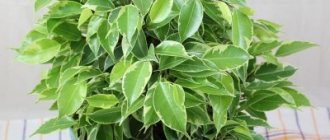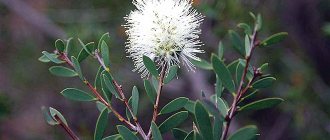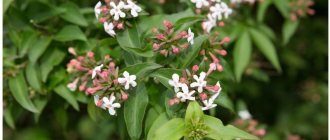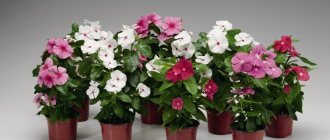Ficus Melanie is a variety of elastic (rubber) ficus.
According to popular belief, this flower ensures family well-being in the home .
With proper care, it will decorate your apartment or office, but you need to take some precautions due to the fact that the plant contains toxic juice.
How to choose
You need to buy Melanie in spring or summer, choosing a young, healthy plant - this way it will better take root in new conditions. The leaves should sit firmly on the branches without falling off. To check, it is recommended to stroke the bush “against the leaves” and see if they all remain in place. At home, wipe the ficus with a wet cloth, since sellers may have treated the leaves with polish for shine. Place it away from other plants for a few weeks and monitor it for diseases and pests.
This variety is quite common and can be easily found in a store (or bought secondhand). The average price for an adult specimen with a height of 50-55 cm is 1,500 rubles. A young ficus 20-25 cm tall is sold for 400-500 rubles. Variegated plants may cost more, but not significantly.
Description
Melanie Elastica is a compact plant reaching a height of 60-65 cm. Ficus bushes beautifully, forming a lush crown with shiny leaves. The leaves are distinguished by their oblong shape with a narrowed, sharp tip. Dense, glossy, leathery, densely located on the stem.
The length of the leaf is 12-15 cm, the width is no more than 7-8 cm. It is dark green on top and olive green on the bottom. The upper vein is light, the lower one is reddish. New leaves on a healthy plant grow quickly - one each week. With age, it develops aerial roots, but flowering at home cannot be expected.
Common varieties
The most common varieties of rubber-bearing ficus are:
- Abidjan - the plant loves bright light, has oval leaves of a dark green color, pointed at the end.
- Belize - a feature of the variety is white and pink stains along the edges of the leaf plate.
- Melanie - this ficus has dense foliage, the length of the plate is 15 cm.
- Robusta - the variety is the most unpretentious, the leaf length is 30 cm, the shape is ellipsoidal.
- Black Prince - the foliage color of this variety is the darkest of all. The leaves are round, their shade changes in accordance with changes in the light in the room.
- Tineke is a variegated variety; along the edges of the foliage you can see a white or cream border.
- Shriveriana - ellipsoidal foliage has a marble color, the length of the plate is 25 cm and the width is 18 cm.
- Tricolor is a variegated variety, the foliage has an interesting marble pattern.
- Decor – dark green foliage with a burgundy tint, the length of the plate is 18 cm.
Growing conditions
To successfully grow a rubber-bearing ficus, it needs to create comfortable conditions:
- Good lighting, but not in direct sunlight. (It is better to place the flowerpot in the southern part of the room and gradually rotate it so that all the leaves reach towards the sun, forming a beautiful crown.)
- The permissible temperature range is from 15°C to 30°C, but the most desirable is from 22°C to 25°C. (In the hot summer, the leaves need to be moistened by wiping with a sponge).
- Normal humidity for ficus is 45-60%. (In dry and hot weather, plants need to be sprayed with a spray bottle).
Transfer rules
Ficus Melanie does not need frequent transplants. Replant only in cases where the root system becomes crowded in the flowerpot. If the plant was purchased in a small glass, it is better to immediately transplant it into a larger container.
The best time for this procedure is spring or the first month of summer. It is carried out using the transfer method: the flower is removed from the container along with the earthen lump and transferred to a new pot. A special nutrient substrate for ficus plants is used as additional soil. After replanting, water the plant (and continue to do regular watering as the soil dries).
Ficus Melanie: home care
As already mentioned, the plant is not particularly whimsical. However, it is not recommended to treat this too carelessly. Caring for Melanie comes down to regular watering, systematic application of fertilizers, annual pruning and replanting.
In addition, it is recommended to follow some rules:
- The frequency of watering should be adjusted depending on the level of humidity and temperature in the room, time of year, lighting and characteristics of the substrate. It is recommended to be guided by the state of the latter. The plant needs watering when the soil is completely dry or slightly damp. It’s quite simple to check this, just stick your finger into the pot and if there is still stuck soil on it, water it early. If the soil turns out to be too dry, crumbly, or, on the contrary, hardened, it’s time to moisten it. In summer, it is recommended to add water several times so that it begins to accumulate on the tray. After it has drained after half an hour, you should drain the excess. In winter, watering should be moderate; excessive amounts of moisture at low temperatures can destroy the tree;
- Along with watering, it is important not to forget about the need to systematically spray the leaves. It should be done when the air is dry during winter heating and summer heat. In this case, you should use only water at room temperature, which has been allowed to settle;
- It is recommended to apply fertilizer twice a month in summer and once in winter. It is important to take into account that fertilizing should be done on the day when the plant was watered, or on the next day, so that the soil is moist. It is recommended to choose liquid fertilizers and not apply fertilizers within a month from the moment the tree is transplanted. If you neglect this rule, there is a danger of damaging the roots, since there are enough useful compounds in fresh soil and without fertilizers. Their excess can negatively affect the well-being of the plant.
Systematic watering and regular fertilization are the key to rapid growth. Following simple care rules will not take much time, but will ensure results.
Let's watch a video about proper care of ficus Melanie at home:
Care
Excellent and picky flower
Caring for the plant is not difficult - just follow a few simple rules:
- Watering is carried out as needed when the top layer of soil dries out. Water moderately, using lukewarm, settled water. Overmoistening creates an even greater danger for this flower than drying out the soil.
- Melanie needs timely feeding: in summer - more often (every two weeks), in winter - less often (monthly). Universal complexes for indoor plants are suitable as fertilizers.
- Pruning is carried out in late winter (or early spring) to form a lush crown. In young bushes, the growing point is pruned; in adults, 5-6 internodes are cut from above.
Reproduction
At home, two methods of propagation are used: cuttings and air layering. A healthy leaf is selected from the plant, cut off and kept in water (in a glass or under running water) until the milky juice stops flowing. Then it is placed in a glass with Kornevin solution. You can wait for the roots to form directly in the water or place the cuttings in a special substrate (peat, river sand and sphagunm). For successful root formation, high humidity is required, for which the ficus is placed in a greenhouse.
A useful nuance: it is convenient to use the top of the bush, which remains after pruning, as a cutting.
To propagate in the second way, the stem under the leaf is cut vertically. The match is dipped into Kornevin powder and inserted into the incision. Wrap this area with damp moss using film. After 2-3 months, roots appear, after which the cuttings are cut off and replanted.
Ficus Melanie, reproduction features, propagation by cuttings
There are two options for propagating a tree.
Depending on personal preferences, you can choose to plant by cuttings - for this it is recommended to cut off a sufficiently strong apical or lateral shoot so that at least three leaves remain on it.
There is no need to sprinkle the cutting areas with charcoal; it is recommended to immediately place the cuttings in water to drain excess juice. The next day, the water needs to be changed and the jar with the cuttings covered with polyethylene to simulate greenhouse conditions.
To speed up the process of root growth, you can add a growth stimulator to the water. After the formation of the first roots, the cuttings need to be transplanted into a pot with substrate.
Planting by air layering - this method is not suitable for beginners; in order for planting to be successful, you need certain gardening skills.
To begin with, it is recommended to cut the stem by a third, so that the cut comes out oblique, insert a match into the cut site, which will prevent the cut from growing together. Wrap peat and a bag over the top, wait until the roots form, after they appear, cut the seedling just below the cut line and plant it in the prepared substrate.
When choosing a planting method, it is important to consider how skilled the gardener is at the task. To begin with, you shouldn’t take risks; it’s better to plant ficus cuttings.
Diseases and pests
The main signs of the disease are falling leaves or the appearance of dark spots. Most often, the cause is improper care. Leaves fall off due to excessive watering, as well as from lack of light. Brown spots may be the result of sunburn. Yellowness appears in extreme heat and dry air (for example, if the plant is standing next to a radiator during the heating season).
Among the insects that cause damage to the flower are scale insects, mealybugs and spider mites. Regular inspection of leaves is necessary to spot pests in time. At the first signs of invasion, the bush is washed with a solution of laundry soap, and then under the shower. Thrips can also be a nuisance (in dry air conditions), which can only be gotten rid of with insecticides.
Sanitary pruning
Sanitary pruning of ficus is impossible without regular inspection of the plant. Only by paying attention to the flower can you promptly identify damaged, dried out or disease- or insect-damaged shoots that need to be removed. More precisely, the damaged shoots themselves, of course, no longer need anything. But if you want to keep the flower safe and sound, you cannot do without sanitary pruning.
It will be difficult for those gardeners who grow deciduous varieties of ficus. Such plants shed their leaves only in the fall, so it will be quite difficult to detect damaged shoots before the onset of the autumn season. However, whatever one may say, you will need to get rid of the damaged branches immediately after detection, otherwise the disease risks spreading to other parts of the ficus.
If the branch is old, if the shoot is weakened, they also need to be eliminated. You, of course, can leave the stem on the plant, but know: if the ficus is attacked by a disease or pest, they will start from those branches whose immunity leaves much to be desired. The entire damaged part of the shoot must be cut off. If we are talking about a stem that develops directly from the ground, shortening must be done directly along the ground line.
Growing problems
- If the leaves fall off en masse, the problem may be due to improper placement of the flower. Melanie cannot tolerate drafts - she needs a comfortable and stable temperature regime.
- Sometimes the bush becomes covered with small brown spots, although all measures against sunburn have been taken. In such cases, you should pay attention to fertilizing. Overfeeding with organic matter negatively affects the health of the flower.
- In the first year, it is better not to propagate Dutch rubber-bearing ficuses - it may not work. Manufacturers often treat them with growth stimulants, which suppresses root formation.
Signs and superstitions
- There is a superstition that this plant keeps men away from home, which is why it is not recommended for married or unmarried women. On the other hand, the flower removes negative energy, so the essence of the sign changes somewhat: the ficus drives away only unsuitable applicants and helps to break ties that will not lead to anything good.
- If you place Melanie in the kitchen, there will always be a lot of food, money and pleasant guests in the house. For financial success, a decorative bush can be placed in the office. However, if leaves fall from a flower for no apparent reason, be careful not to lose income. (And, of course, reconsider your plant care measures.)
- If you want a new cash influx, try to make the bush more beautiful and luxuriant. Take care of proper pruning and fertilizing, care for the flower with love, do something good for it every day (spray it, wipe the leaves, turn it towards the sun, or just say a few nice words).
How tall does Ficus Melanie reach?
Like many other plants, in the wild it can reach a height of thirty meters. At the same time, the ficus ceases to be just a “tree”; it is already a real tree, which with age begins to form aerial roots.
In the plant’s homeland, these aerial roots, which are particularly dense, are used to build suspension bridges that are not only capable of supporting the weight of fifty people, but are also constantly renewed naturally and do not need to be replaced.
Melanie does not reach such huge sizes in indoor conditions.
The height varies from fifty centimeters to a meter, depending on the conditions of care, the frequency of pruning, and the conditions in which the tree grows.











